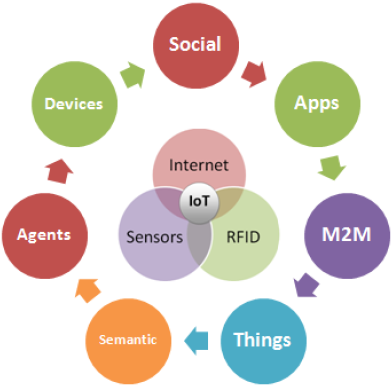Journal of Mobile, Embedded and Distributed Systems, vol. V, no. 3, 2013ISSN 2067 – 4074www.jmeds.eu

Figure 1. Internet of Things components
A Smart Object contains IoT data and
information, also metadata and software agent
code resources, such as application software
event handler. Samples of Smart Objects are
embedded devices such as Rasberry Pi,
Arduino, BeagleBone/Ninja Blocks. The data model for broad interoperability is represented
by the Smart Object API.
The Smart Object API is represented by a
Semantic Web application for the Internet of
Things that provides linked-data interactions
between application software agents and IoT
endpoints, sensors and user devices, which are
pluggable in real-time [1].
The IoT vendor silos provide high level cooked
APIs from cloud services of Smart Object API,
enabling integration of IoT resources from top to
bottom of the stack. The IoT of today means no
interoperability and existence of many vertical
and horizontal silos.
The Smart Object API supports the concept of a
Smart Gateway, which is working as a Smart
Object intermediate for devices on the network,
adding semantic descriptors and offering a
service interface for the device representation on
the Internet. Sensors and gateways must be
programmed for each service they need to
interact with.
IoT applications consist of sensors and actuators
end points, user device end points, and
application software that connect the endpoints
in the representation of a directed graph. We can
also build a graph of resources consisting of
Smart Objects connected to services and other
Smart Objects, based on the related IoT
ontologies, and the Smart Object API [2].
The
interoperability and
interdependence
between multiple devices is becoming a common
characteristic because people are trying to build
their own Internet of Things by getting all their
smart devices to be connected in the cloud. The
IoT needs a standard to interact with other
devices and this standard must enable software
for easier interaction.
The actual Internet of Things consists of many
different sensor networks and protocols,
connected to special cloud services and offering
access through smart mobile devices and
browser applications. It is unusual for these
separate silos to cooperate or interact one with
each other [3].
Figure 2 describe the Internet of Things tech
items grouped on three main categories: Internet
– Protocols – Middleware, Sensors – RFID,
Embedded Devices – Smart Objects.
125
- ↑ Ibid.
- ↑ Ibid.
- ↑ Tom Vu, The Internet of Things: Inspiration and Requirements, Available at: http://blog.makezine.com/2013/04/18/the-internet-of-things-inspiration-and-requirements/
